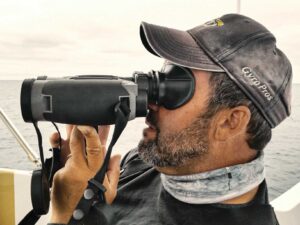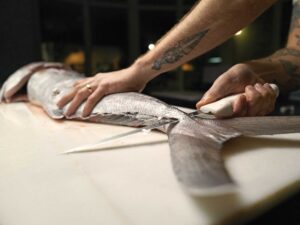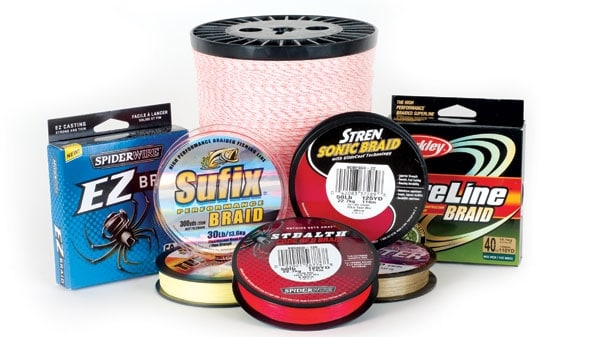
It might appear a bit unusual to chunk for sizable yellowfin tuna with 12- and 16-pound-class conventional tackle unless you’re simply seeking a prolonged fight on light line for bragging rights. After all, who would compromise delicious yellowfin tuna steaks by burning out a tuna or risk such a quality fish to sharks via a long, tedious battle? In tuna fishing, the quicker you bring the fish to gaff, the better. Yet numerous anglers are indeed bringing such light tackle to the game – save for one major modification: heavy line.
Confused? Don’t be. Welcome to the top-shot revolution, in which ever-increasing droves of anglers are going the braid-monofilament top-shot route to gain line capacity, and also comfort, when pursuing their favorite big game fish. The quality build of modern reels and the effectiveness of their drags make heavy lines manageable on smaller reels; the strength versus diameter of braided lines allows more heavier-test line to be loaded on the smaller-capacity reels. It’s this match that has opened the door to the top-shot revolution. And you can sift me into that group, as I’ve converted my 16-pound-class lever-drag reels to this setup for my Bahamas yellowfin tuna chunking. I’ve also switched over many of my lighter reef, offshore, live-bating and casting outfits – spinners included. More on these outfits later.
The Conversion
I became a big convert a few seasons ago, when a couple of friends in the Northeast showed me how they spool a Penn 16 with 80-pound braided line followed by a 200-yard top shot of 50-pound-test monofilament line. This has become a hot setup for canyon tuna chunking.
The advantage of this, compared to bigger and heavier 50-pound and larger tackle, is it enables anglers to hook, fight and land one tuna after another with very little fatigue. Plus, some charter captains have found the lighter reels prove much easier for inexperienced clients to handle through the full process of chunking, hooking a fish, removing the outfit from its gunwale holder and then fighting the fish. This makes such folks who pay just shy of a king’s ransom for an overnight canyon charter feel like an essential and effective part of the team and not simply spectators.
Another huge advantage, naturally, is line capacity: Should a large tuna or swordfish pick off a bait behind an anchored boat, this setup should provide enough line capacity for fighting the fish while it remains on the hook or, at the very least, allow ample time for tossing the anchor line and float ball and chasing it down. So I reasoned that if such a setup works wonders in the mid-Atlantic and Northeast canyons, it should prove ideal for my offshore pursuits in the Bahamas and south Florida. Naturally, the same would hold true for the Gulf of Mexico, Southern California and Mexico’s Baja California.
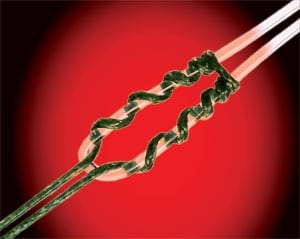
What You Gain
The exact amount of line capacity acquired is based on the ratio of braided line to monofilament line you opt for – and yes, there are preferences, based on species and conditions. However, as a general rule, you should come close to or exceed the amount of line a specific reel is rated to carry. For example, my Penn 16 International is advertised as holding 480 yards of 30-pound-test monofilament line (a common choice of line for this reel, which holds an exorbitant 1,075 yards of straight 16-pound-test monofilament) or 700 yards of 80-pound-test braided line. For my Bahamas tuna chunking, my reels are spooled with approximately 400 yards of 80-pound-test Sufix Performance Braid followed by a 200-yard top shot of 50-pound-test Sufix Superior monofilament line, for a total of around 600 yards of heavy line – very impressive considering the small and light stature of these reels. Of course, line capacity can be bumped up proportionately by using more braid than mono.
This setup gives not only more-than-ample line capacity to whip the larger yellowfins but also the option to deploy these outfits on the troll for a variety of species; should we hook a marlin, there’s enough line for us to chase down, fight and beat the fish. Again, like with the canyons example mentioned earlier, I’m seeking the comfort and ease these lighter outfits bring when chunking and live-bating tuna, along with the strength the braid-mono top shot provides.
Trolling Formulas
Even my 30-, 50- and 70-pound-class dedicated trolling outfits adhere to the same braid-mono top-shot ratios. That is, 50-pound-test braid backs 30-pound monofilament, 80-pound-test braid is behind 50-pound-test monofilament, and 100-pound-test braid is behind 80-pound-test monofilament for these reel classes, respectively. In this case, I’m seeking extra line capacity, especially when I’m in the far southeastern Bahamas, where hooking a large wahoo, marlin or tuna is likely.
Since braided line has a significantly smaller diameter than nylon monofilament of the same breaking strength, I opt for a stronger braid backing than the designated line class for the reel. I adhere to the latter when choosing the monofilament top shot. One exception is my tuna-chunking outfit, which uses the 80-50 ratio. But that’s for specialized fishing.
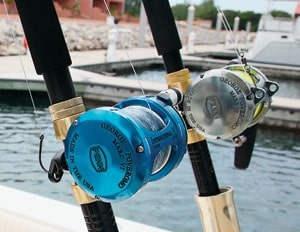
General Logic
I’m often asked why I don’t use braided line exclusively, along with a long monofilament or fluorocarbon leader, for offshore trolling. When trolling offshore, I like the inherent stretch in monofilament line, which acts as a cushion. This comes into play with marlin and other powerful and perhaps acrobatic fish, which surge and run and may leap quickly and powerfully. This extra bit of stretch can be just enough to keep the hook from tearing free or straightening out. Also, the monofilament is much more forgiving when multiple tunas or other doubleheaders create crossed lines. Braided lines in such a predicament often result in cutoffs.
Many people attach braid to monofilament with small offshore swivels, which provide a quick connection. I’ve never felt comfortable hearing and feeling these swivels pass through the rod guides when I’ve used such setups. They’ve always held, but I worry about the wear on the guides and the possibility of their corroding and failing if not properly cared for.
When joining braid to mono, I prefer the cat’s-paw connection. This entails putting a short double line in the braid and a short double line in the mono (keep the mono on the spool during this stage). Then interlock the two loops, and pass the spool of monofilament through these loops five times. Snug down the connection, and wind on the monofilament top shot. The connection is small and secure.
Smaller Stuff Too!
As previously mentioned, I’ve even gone the braid-mono route for my smaller nearshore and offshore tackle. For example, looking for line capacity and solid abrasion-resistance when anchored up and free-lining live baits on a reef, I’ve spooled my small and next largest conventional reels primarily with 30- and 50-pound braided line, respectively, and a 20-foot 30-pound-test fluorocarbon top shot. This way we can hook an outsize king mackerel – and when we’re not fast enough to reel away a bait, the occasional shark – on the sporty small reels and not have to get off the anchor to pursue them. We often use these same reels when drifting the reefs for a mixed bag that includes everything from sailfish to grouper to cobia. On the drift, line capacity isn’t as critical an issue, but it sure is nice having enough backbone to battle fish on such small outfits.
As for spinning tackle, this has become a go-to setup for those big offshore spinning reels. In fact, I’ve even spooled my smaller 12- and 20-pound-class spinners with 20- and 30-pound-test braided line and 12- and 20-pound-test mono top shots, respectively. These top shots average around 20 feet in length. Again, I’m looking for line capacity with the braid and enough cushion to absorb surges with the mono. These top shots, incidentally, are not the actual leaders, except when we’re casting to blackfin tuna. These spinners come into play when casting lures and baits to dolphin, cobia and blackfin tuna.
In the offshore world, the braid-mono top shot is a hot setup for the reasons outlined here. It brings a certain comfort to fishing, with tackle that’s strong enough to whip powerful fish yet light enough not to wear out the angler. Best of all, it puts big fish in the boat and even bigger grins on everyone’s faces. And what’s not to like about that?

